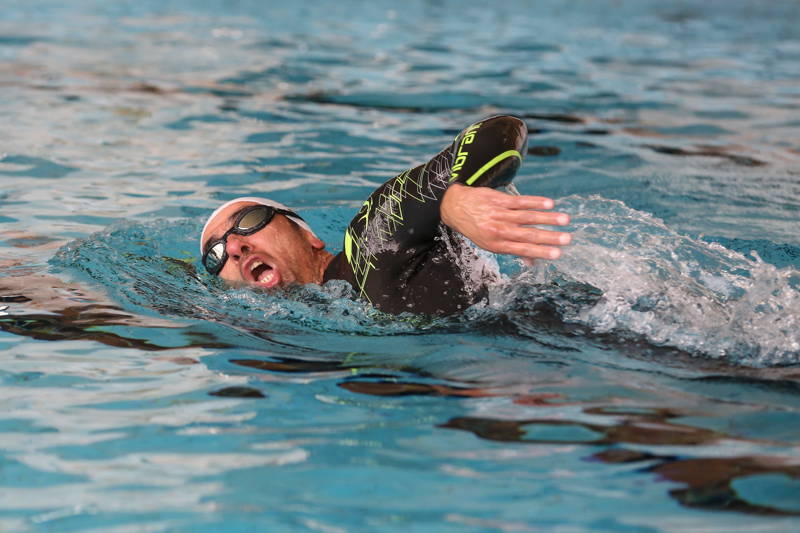Einfach ins Wasser, irgendwie bewegen und los! Das ist eine, beim Schwimmen häufig gesehene, Herangehensweise die aber leider ziemlich ineffizient ist. Besonders beim Kraulschwimmen ist die Technik von großer Bedeutung um sich ökonomisch und schnell im Wasser fortzubewegen. Wichtiger Bestandteil ist hier die Körperrotation, da diese eure Gleitphase verlängert, eurem Zug mehr Kraft verleiht und euer Tempo erhöht. Hier bekommt ihr 2 Übungen wie ihr eure Rotation verbessern könnt und worauf ihr dafür achten müsst.
Wenn man sich gute Kraulschwimmer ansieht, fällt auf, dass diese nie lange flach im Wasser liegen sondern sich stetig um ihre Längsachse drehen. Neben den oben genannten Vorteilen verbessert das die Wasserlage, ermöglicht entspannteres zurückholen der Arme mit hohem Ellenbogen und erleichtert gleichzeitig die Atmung. Aber bei falscher Technik kann es dazu kommen, dass der Arm zu früh absinkt und dadurch die Gleitphase abrupt beendet wird. Um das zu vermeiden geht es jetzt los mit den Übungen.
Übung 1 - Gleitarmstreckung
Hier müsst ihr euch erstmal nur auf euren Gleitarm konzentrieren. Sobald dieser ins Wasser eintaucht, müsst ihr versuchen ihn so weit wie möglich nach vorne zu schieben. Wenn ihr denkt, weiter geht es nicht dann streckt eure Fingerspitzen noch ein kleines Stück weiter Richtung Wasseroberfläche und schon spürt ihr, wie sich euer Zug und eure Gleitphase signifikant verlängert haben.
Übung 2 - Das Grillhähnchen
Wie beim Namensgeber der Übung liegt hier der Fokus auf eurer Längsrotation. Achtet darauf, dass euer Po und Bauch während der Durchführung dieser Übung nicht absinken. Begebt euch in Bauchlage und beginnt mit einem konstanten Beinschlag, der euch stetig nach vorne befördert.
Eure Arme liegen dabei ausgestreckt vorne. Leitet jetzt eine Drehung um 90 Grad in die Seitenlage die ein und stellt euren Unterarm bis zur Höhe eures Ellenbogens an. Dreht jetzt eure Hüfte weiter, bis die Seitenlage erreicht wurde und merkt wie der vordere Arm dadurch automatisch nach vorne geführt wurde und dahin gleitet. Während dieser Position führt der Beinschlag weiterhin für Vortrieb und ihr habt genug Zeit um Luft zu holen, die Gegenrotation in die Bauchlage einzuleiten und euren vorderen Arm mit hohem Ellenbogen zurückzuholen.
Verzichtet auf Hilfsmittel
Der jetzige Punkt wird vielleicht einige von euch etwas stören. Allerdings verhindern Pull Buoys, auch wenn sie die Beine angenehm entlasten, eine gute Rotation, da diese mit den Bojen zwischen den Beinen sehr anstrengend ist und viel Konzentration auf Arme und Drehung erfordert. Deswegen wählen die meisten dann die leichtere Variante und verzichten auf die Rotation, was aber eure allgemeine Technik verschlechtert.
Flossen können helfen
Ein Hilfsmittel, was eure Rotation tatsächlich verbessern kann sind Kurzflossen. Durch diese habt ihr mehr Vortrieb nur durch euren Beinschlag was eine erhöhte Konzentration auf Arme und Drehung ermöglicht und gleichzeitig eure Beinmuskeln trainiert. Aber: Schwimmt anfangs nicht mehr als 600 Meter mit Flossen, da sich die Muskulatur erst an die größere Belastung gewöhnen muss.
Trainingsplan
- 300m locker einschwimmen
- 100m Rückenschwimmen (achtet auf gute Wasserlage und lockeren Beinschlag)
- 200m 5 Züge Rücken und 5 Züge Kraul (achtet auf eure Drehung)
- 200m locker Kraulschwimmen
4 x 100m, davon 50m Technik und 50m ganze Lage
- Abschlagschwimmen und auf Rotation aus der Hüfte achten
- Abschlag und auf Rotation achten, während man den Arm nach vorne schiebt
- 2 Runden Abschlag frei, aber Fokus auf Rotation
200m locker Kraul
6 x 50m Armzüge zählen und pro Bahn um einen reduzieren (Tipp: mehr Beine, bessere Rotation, …)
100m locker Rücken, nochmal Fokus auf Wasserlage
200m locker ausschwimmen




















